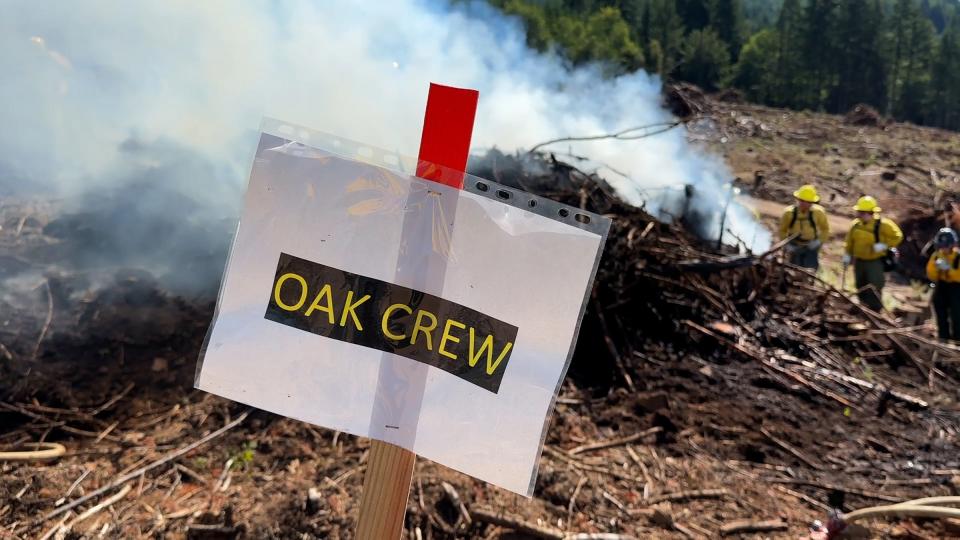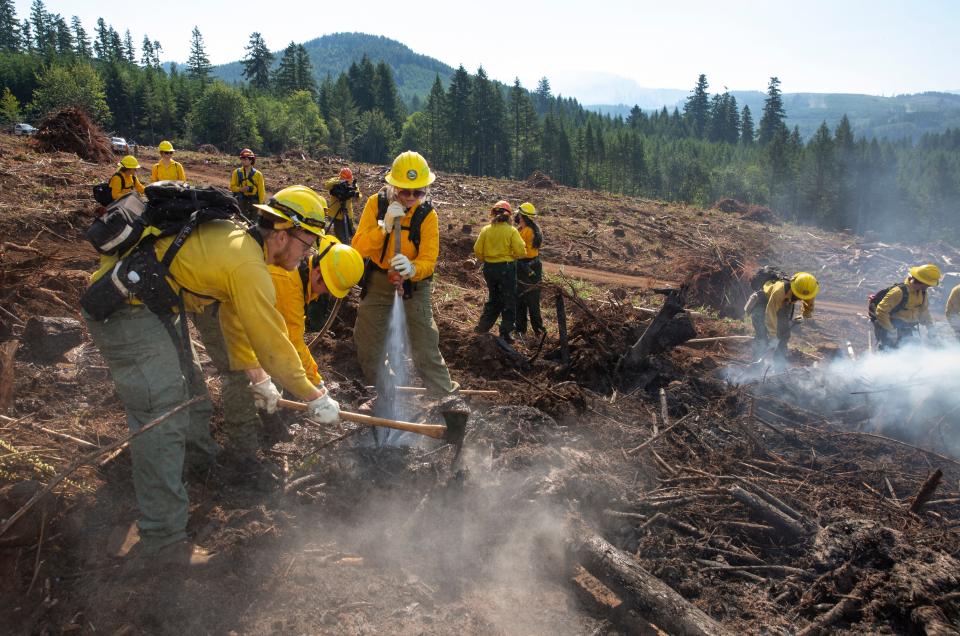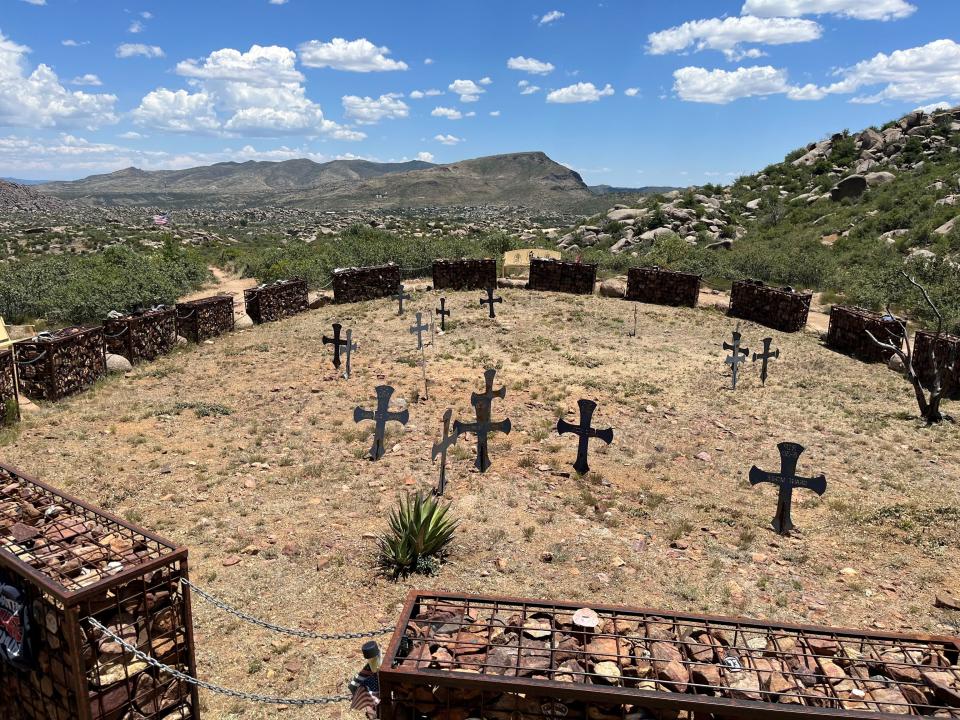Becoming a wildland firefighter: Students train for their first wildfire season
With smoke burning their eyes and lungs, and the heat from the sun and flaming piles of brush beating into them, nearly 200 young firefighters faced their first live fire.
Over five days of intense instruction, the newly certified wildland firefighters completed their training in preparation for 2023's fire season, which officially began July 1. On June 30, in a culmination of all their in-class and hands-on training, the trainees fought a carefully set series of burning piles of dried grass and wood intended to mimic a genuine wildfire.
"I've never fought fire directly before," said 21-year-old Jack Hayward, an Oregon State University student who grew up in Portland. "Just even with these like smoldering piles, you can feel the heat intensely from, like, 30 feet away. You're just getting cooked when you're digging the line, so that was really surprising. But I've really been looking forward to this all week."
The Mid-Willamette Valley Interagency Wildland Fire School in Sweet Home is an annual five-day course held in the last week of June.
All students are employed by one of the participating agencies, which fully fund their course, including ODF, fire departments around the state and university programs. They must be approved by a supervisor to take the course.

Trainees learn about fire behavior, suppression tactics, weather impacts, mapping, compass use, teamwork, leadership, safety and fire investigation. The majority of the trainees earned their Firefighter 2 certification, qualifying them for an entry-level position. This certification meets a national standard.
"We'd start the day with about five hours of class time where we learn tactics, how to look at the weather, how to fight fires a team, just kind of general things," Hayward said. "Then we'd come out here and we'd apply that knowledge directly to hands-on training."
The trainees came from different states and a variety of agencies, learning about ways they can help during fire season.
Hayward is on the student logging crew from OSU, and, like many of the other trainees, is expecting to help out in case of nearby wildfires. The OSU Student Logging Training Program offers training in practical logging and forestry skills. He said his boss sent him and his fellow crew mates to the fire school to learn more about that side of forestry.
"I did forestry because I like restoration, and I really like the process of logging to kind of just better the world around us to healthy logging and maintenance, making sure things don't get out of hand with harvesting," Hayward said. "(Fire school) has been just a great learning experience."

New faces
Many of the trainees donned shiny new firefighting attire while instructors wore versions dulled from years of smoke and experience.
The live fire practice is as close as you can get to a real-life wildfire. The trainees were divided up into about a dozen crews, each in charge of putting out two burning piles. The trainees report to their crew leads, who report to division supervisors, a military-type hierarchy that helps keep order during a real fire situation.
Sinjin Wheatley, who was a course instructor, lead some of the crews as the Division Alpha supervisor for the live fire training.
"Seeing a whole new batch of firefighters come in, I think it's pretty nostalgic for everyone that's out here that's been doing this for a while," Wheatley said. "We see new faces every year, and most of those faces are pretty eager, so that's really nice to see."
Learning what it means to be a firefighter
Gillian Peden, 22, grew up in Eugene and now studies environmental studies at the University of Oregon, expecting to graduate in 2024.
She said the training changed her view of firefighters.
"I had a preconceived notion of what it meant to be a firefighter. But actually getting this job and being out here today, learning from my supervisors from my peers, it's just an ultimate sense of resilience and self-sacrifice for your team," Peden said.

Peden added that firefighting is all about protecting the public and the ecosystem.
"There's long shifts, long hours, a lot of dirty work on your hands and knees, but that is really for the greater good of the community and for your department," Peden said. "I've learned what it takes to really push my physical boundaries, what it takes to put my push my mental boundaries."
While pushing herself to her limit, spending long hours in the heat and potentially putting her own safety at risk, Peden kept in mind the ultimate goal of keeping her community safe.
"It's definitely a learning experience that I'm so grateful to be a part of," she said.
Working as a team
To mimic life in a real fire camp, students slept in tents at Sweet Home High School and ate all their meals communally. Some of the instructors said wildland firefighters can go 16 hours straight fighting wildfires, working as a team the entire time, which can go toward forming deep connections with their fellow crewmates.
"When you're out there, in an active fire, you depend on each other," said trainee Jenna Leichner, 25, with U.S. Forest Service and an OSU student. "If you are not strong and cohesive, that could be fatal."
Fellow trainee Rene Marquez, who is now part of Columbia River Fire & Rescue, is originally from Santa Ana, Calif.
"Not being from around here, (his crew) they've actually taken me in under their wing and treated me a lot like family, and I didn't really expect that," Marquez, 23, said. "Everyone treats one another like a brother or sister. Honestly, if you have a question, they really don't care if you're a first-year or if you're a fifth-year. They're really open to help anybody."
Marquez said his fellow crew members share a passion for the outdoors and conservation.
Leichner, for example, said she hopes to go into the policy side of conservation, mentioning the National Environmental Policy Act, the Clean Water Acts and Clean Air Act. She said this class on active firefighting has been a great opportunity.
"I see all these people willing to put their life on the line and willing to work nonstop for ... the force," Marquez said. "This is what they would want to protect for the rest of their life."
Remembering fallen heroes
June 30 marked 10 years since the Yarnell Hill Fire that took the lives of 19 wildland firefighters in Arizona. The deaths of the Granite Mountain Hotshots from Prescott Fire Department rocked the nation, but their efforts in putting out that fire were not forgotten.
Craig Pettinger, Unit Forester for ODF in Sweet Home, asked the students and instructors to keep them in mind on the anniversary.
Peden reflected on the Granite Mountain Hotshots and other firefighters who've died on the job.
"I know that crew had so much experience and just did so much for the fire community," Peden said. "It's really important to spread the word and honor those who've fought for us and what we've learned from. We can look back on those kinds of situations and increase safety."
The Granite Mountain Hotshots were killed after leaving a black-burned safety zone when a change in wind direction and speed pushed the fire toward them faster than expected and blocked their escape routes. The firefighters deployed their emergency fire shelters but the fire overtook them. They died in the 2,000-degree heat.

Investigations found numerous communication issues on the day they died, and questions remain about why some decisions were made.
Hayward said every day of the course, their instructors reinforced the concept of "if you see something, say something," emphasizing communication and observation as key factors in saving lives.
"It's really just been ingrained in us that you need to be making sure that both you and your crew are okay," Hayward said. "It's a team effort, and it's better to play it safe than be sorry later."
Miranda Cyr reports on education for The Register-Guard. You can contact her at mcyr@registerguard.com or find her on Twitter @mirandabcyr.
This article originally appeared on Register-Guard: Wildland firefighters: Students train for their first wildfire season

